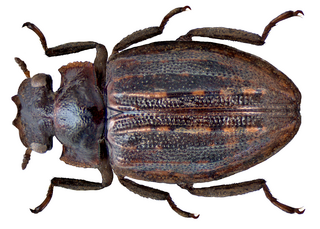
Spercheus is a genus of aquatic beetles which are placed in a family of their own, Spercheidae within the Hydrophiloidea. About 20 species are known from around the world except the Nearctic with the majority being from the Oriental and Afrotropical Realms.

The insects of the beetle family Chrysomelidae are commonly known as leaf beetles, and include over 37,000 species in more than 2,500 genera, making up one of the largest and most commonly encountered of all beetle families. Numerous subfamilies are recognized, but the precise taxonomy and systematics are likely to change with ongoing research.
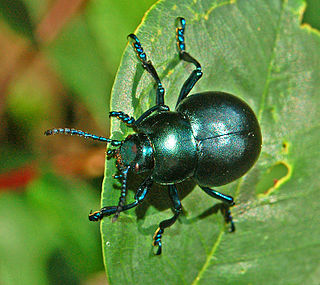
Timarcha is a genus of leaf beetles in the family Chrysomelidae, with more than 100 described species in three subgenera. The most widely known species is T. tenebricosa, the bloody-nosed beetle. All species are black, wingless organisms. Timarcha are herbivorous species, living mostly on plants belonging to Rubiaceae and Plumbaginaceae, although a few can feed on Brassicaceae and Rosaceae. Timarcha is the only member of the tribe Timarchini.

Flower chafers are a group of scarab beetles comprising the subfamily Cetoniinae. Many species are diurnal and visit flowers for pollen and nectar, or to browse on the petals. Some species also feed on fruit. The group is also called fruit and flower chafers, flower beetles and flower scarabs. There are around 4,000 species, many of them still undescribed.

Zabrus is a genus of ground beetles. They are, unusually for ground beetles, omnivores or even herbivores, and Zabrus tenebrioides can become a pest in cereal fields.

Cerambycinae is a subfamily of the longhorn beetle family (Cerambycidae). The subfamily has a world-wide distribution including: Asia, Europe and the Americas. Within the family, the only subfamily of comparable diversity is the Lamiinae.

Lepturinae, the lepturine beetles, is a subfamily of the longhorn beetle family (Cerambycidae), containing about 150 genera worldwide. This lineage is most diverse in the Northern Hemisphere. Until recently the subfamily Necydalinae was included within the lepturines, but this has been recently recognized as a separate subfamily. Nine tribes are usually recognized today, with a tenth, Caraphiini, created in 2016. A few genera are of uncertain placement within the subfamily.

Melandryidae is a family of beetles in the superfamily Tenebrionoidea. Members of the family are found worldwide, with around 420 species in 60 genera. Larvae and adults are generally associated with rotting wood and wood-decomposing fungi.

Glischrochilus is a genus of sap-feeding and predatory beetles under the family Nitidulidae, subfamily Cryptarchinae. Most members of this genus are commonly known as picnic beetles or beer bugs.

Clinidium is a genus of wrinkled bark beetles in the subfamily Rhysodinae. Most species are Neotropical, but some occur further north in North America and there is also one species in Europe and one in Japan. Two species are known from Miocene amber.

Callidiini is a tribe of beetles in the subfamily Cerambycinae, containing the following genera:

Callidiopini is a tribe of beetles in the subfamily Cerambycinae.

Epicauta is a genus of beetles in the blister beetle family, Meloidae. The genus was first scientifically described in 1834 by Pierre François Marie Auguste Dejean. Epicauta is distributed nearly worldwide, with species native to all continents except Australia and Antarctica. Surveys have found the genus to be particularly diverse in northern Arizona in the United States. Few species occur in the Arctic, with none farther north than the southern Northwest Territory of Canada.

The Sepidiini is a tribe of ground-dwelling darkling beetles (Tenebrionidae), that occurs across Africa, the Mediterranean Basin, the Arabian Peninsula and Mesopotamia. It is composed of many hundreds of species. The larvae of some species are known to damage crops.
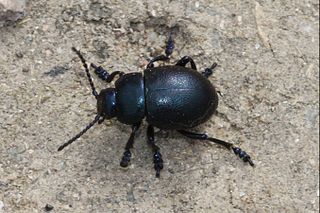
Timarcha goettingensis, commonly known as the Small Bloody-nosed Beetle or the Lesser Bloody-nosed Beetle is a species of leaf beetle native to Europe.
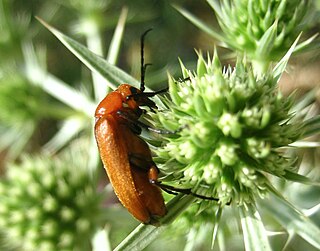
Zonitis is a genus of blister beetles in the family Meloidae. The genus was named and described by Johan Christian Fabricius in 1775.
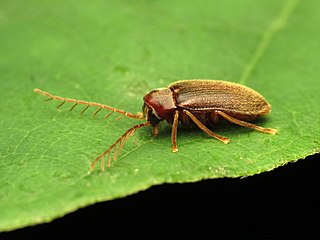
Ptilodactylidae is a family of beetles belonging to the Elateriformia. There around 500 extant species in 35 genera. They are generally associated with riparian and aquatic habitats. The larvae generally live associated with rotting wood or vegetation, or within gravel and detritus on the edge of water bodies. The larvae of some species feed on submerged rotting wood or on plant roots, while the adults of some species are known to feed on fungus with modified brush-like maxillae.
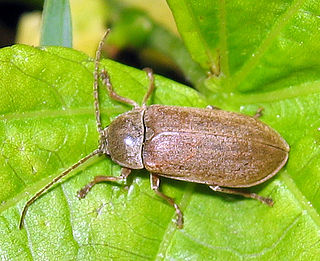
Dascillidae is a family of beetles within the clade Elateriformia. There are about 100 extant species in 11 genera, which are found worldwide. Dascillidae together with Rhipiceridae form the super family Dascilloidea.

Eumolpini is a tribe of leaf beetles in the subfamily Eumolpinae. It is the largest tribe in the subfamily, with approximately 170 genera found worldwide. Members of the tribe almost always have a longitudinal median groove on the pygidium, which possibly helps to keep the elytra locked at rest. They also generally have a subglabrous body, as well as appendiculate pretarsal claws.
Timarcha intricata is a species of leaf beetle in the family Chrysomelidae. It is found in North America.




















